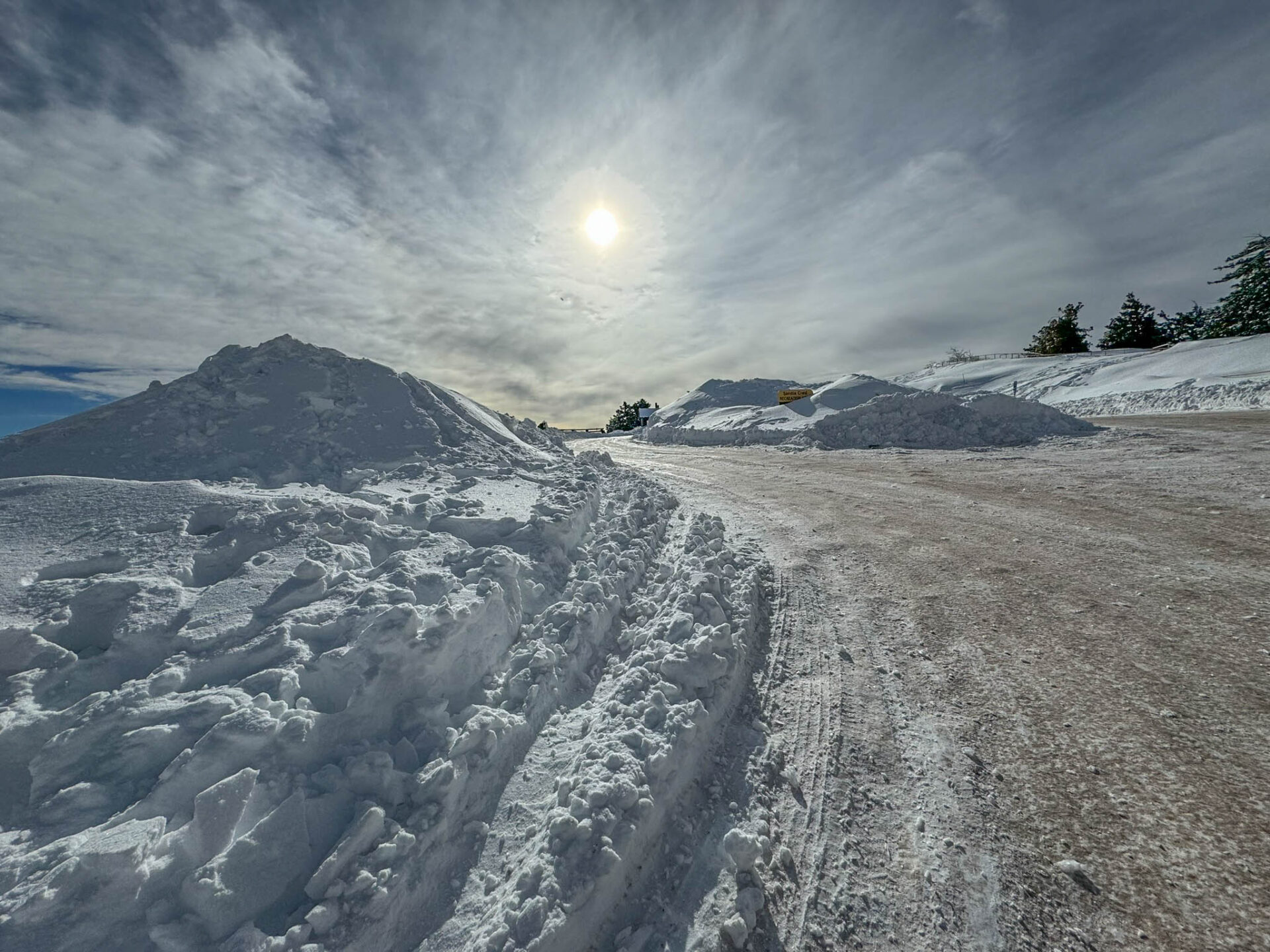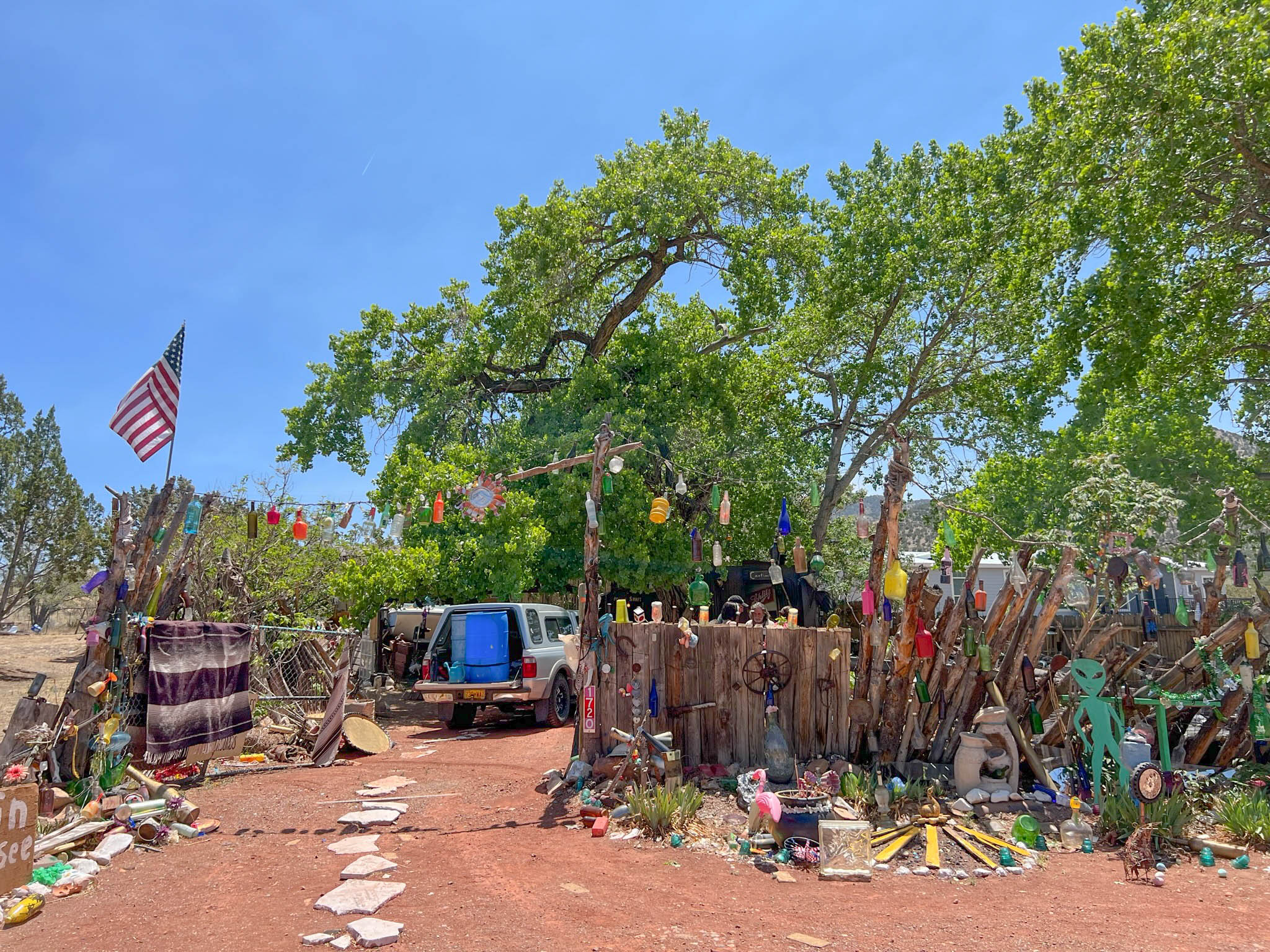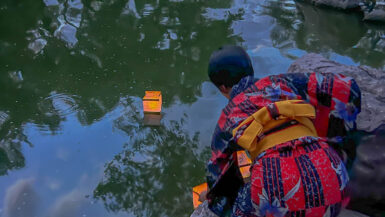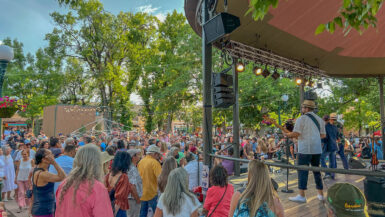Driving up a winding mountain road to an elevation of 10,678 feet, in winter, is not something you’d think many people would be interested in doing, unless it involved skiing, snowboarding, or snowshoeing. But never underestimate the fanaticism of birders. Many birders will drive countless hours and brave all kinds of hostile weather conditions and discomfort, if it means they might spot an unusual bird. Even though I’m not an extreme birdwatcher, and I don’t care about racking up a huge tally of bird sightings, I still found myself driving up to the Sandia Crest summit for the second time in as many weeks, in the hope of spotting rosy finches and perhaps a three-toed woodpecker, red crossbill, and Clark’s nutcracker while I was at it. Here’s how it played out.
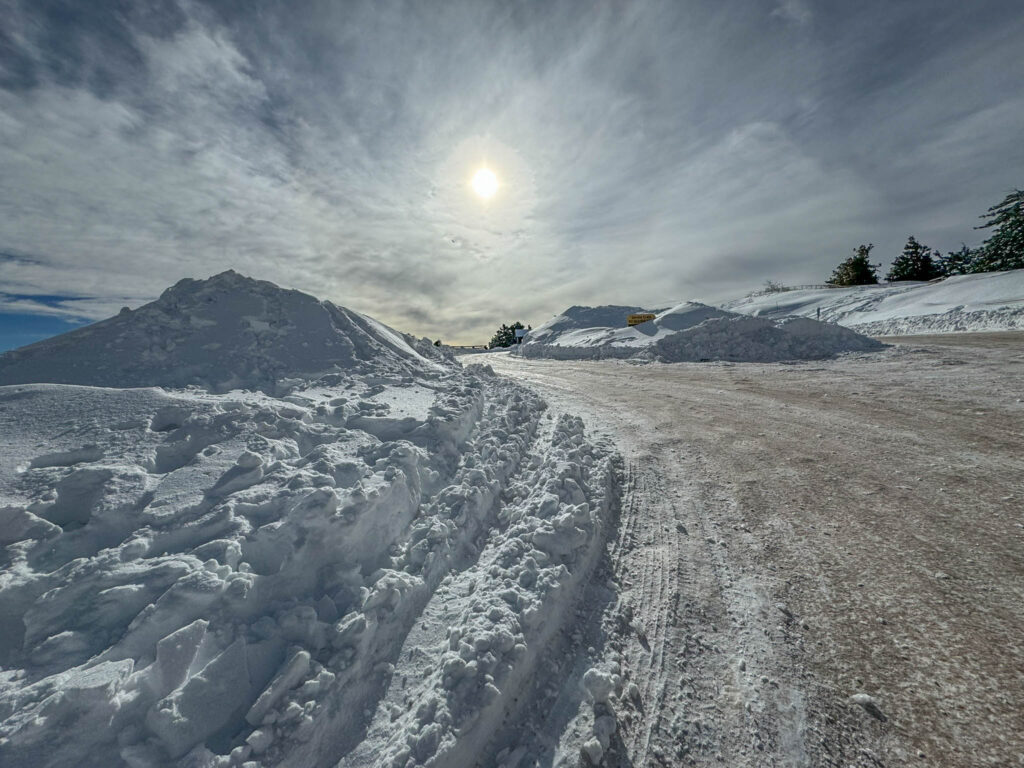
Table of Contents
Where is Sandia Crest and how do I get there?
First things first, let’s start with some basics, such as … where is Sandia Crest, what the heck is a Rosy Finch, and what makes them so special for birders?
Sandia Crest
If you’re standing in Albuquerque, New Mexico, and gaze east, you’ll see the Sandia mountains. If you look carefully, you’ll notice some radio towers sticking up at the summit. That’s Sandia Crest, also known as Sandia Peak or “The Crest”, and it’s the highest point of the Sandia Mountains at 10,678 feet. If you want to get technical, Sandia Crest is not in Albuquerque. It’s actually part of a town called Sandia Park, which happens to be the town where I live.
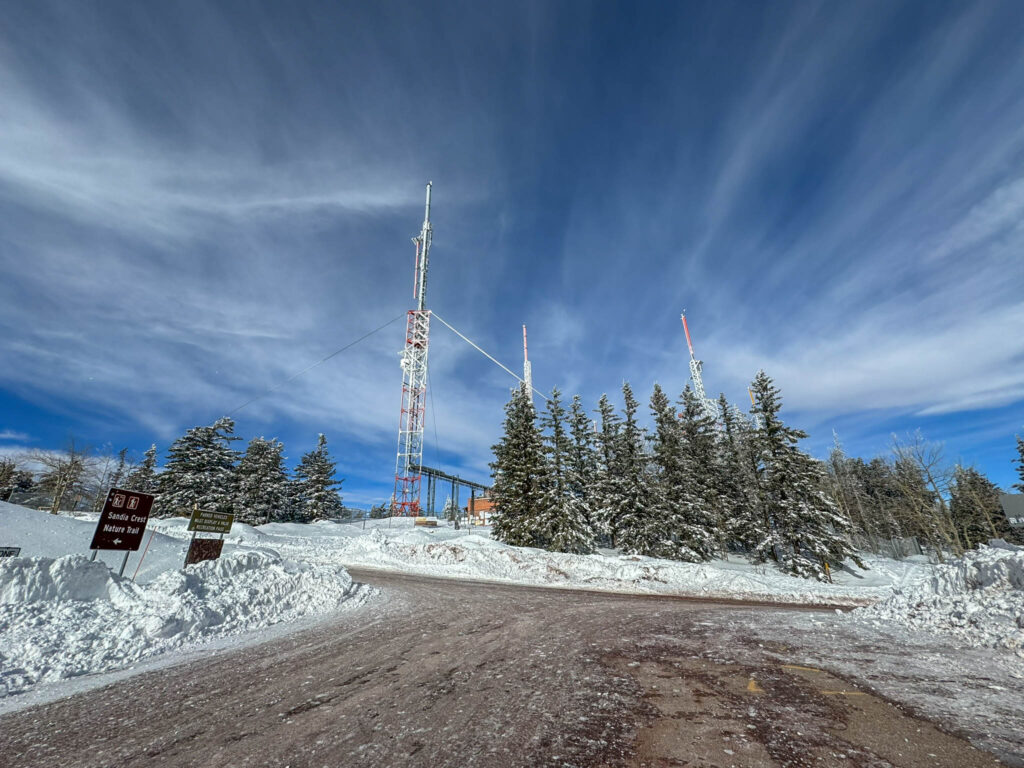
To get to Sandia Crest, you have three options:
- Option 1: Drive. Hop in your car and drive around the backside of Sandia Peak to what is known as “The East Mountains”. You’ll take I-40 East to Tijeras, New Mexico and then take Highway 14 (aka The Turquoise Trail) north for ~6 miles until you see the turn (left) to Sandia Crest Scenic Highway. Turn left and drive 13.3 miles up to the summit. It takes just under an hour to get to the summit it you’re starting from downtown Albuquerque.
- Option 2: Strenuous Hike. If you’re up for a challenge, then hike up to the Sandia Crest summit from one of several trailheads in Albuquerque (ex. La Luz Trailhead) or the East Mountains.
- Option 3: Take the Tram. There’s just one catch to this option: the tram doesn’t take you to Sandia Crest. It takes you to the Ten 3 restaurant (at an elevation of 10,378 feet) and then you’ll need to hike 1.75 miles one-way to get to the bird feeder at the Sandia Crest House. After birding, then you get to do it all again in reverse to get back home, unless you decide to hike down.
For this article, I’ll focus on Option 1: driving to the summit.
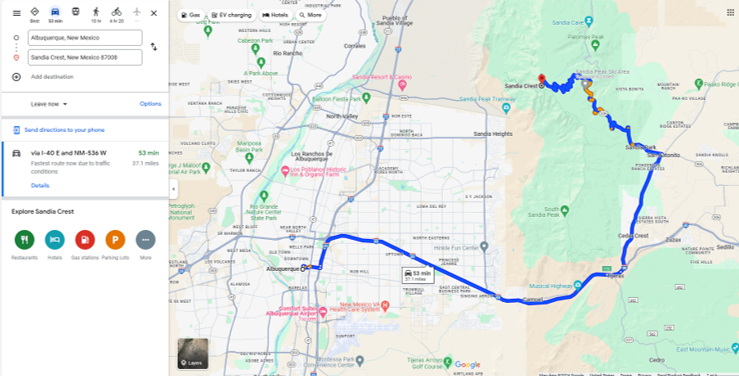
The drive to Sandia Crest
Unless you’re one of those motorcycle riders who enjoy speeding down the Sandia Crest Scenic Highway, it’ll probably take you just under 30 minutes to drive up and 30 minutes to drive down from the intersection of Sandia Crest Highway and Highway 14. In the summer, you may encounter many cyclists who enjoy the challenge of the long climb to the summit, followed by the reward of a long, high-speed, downhill descent. In the winter, not so much.
You’ll likely want to check the road conditions before making the drive, as the roads can get pretty sketchy with snow and ice. Weather conditions at the top of Sandia Peak can be very different from what you’ll find in downtown Albuquerque.
During my two drives up to the summit (December 26 and January 1st), the roads were in decent shape, but there were quite a few icy patches along the way.
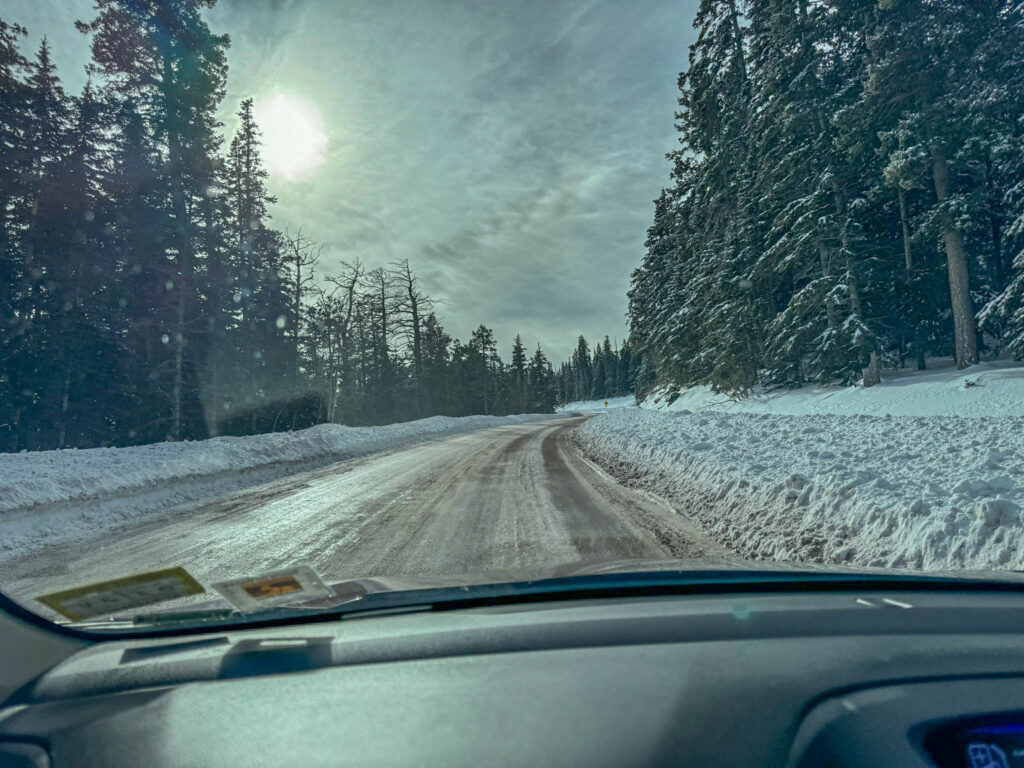
On my way up the mountain on the morning of New Year’s Day, I came across a car that had a different interpretation of “ride the rails” during its descent from Sandia Peak. This was relatively early in the morning and there was nobody around, so it must have taken place on New Year’s Eve. Still, it’s a good reminder to take it easy on this road, especially if you don’t have 4-wheel drive or All-wheel drive.
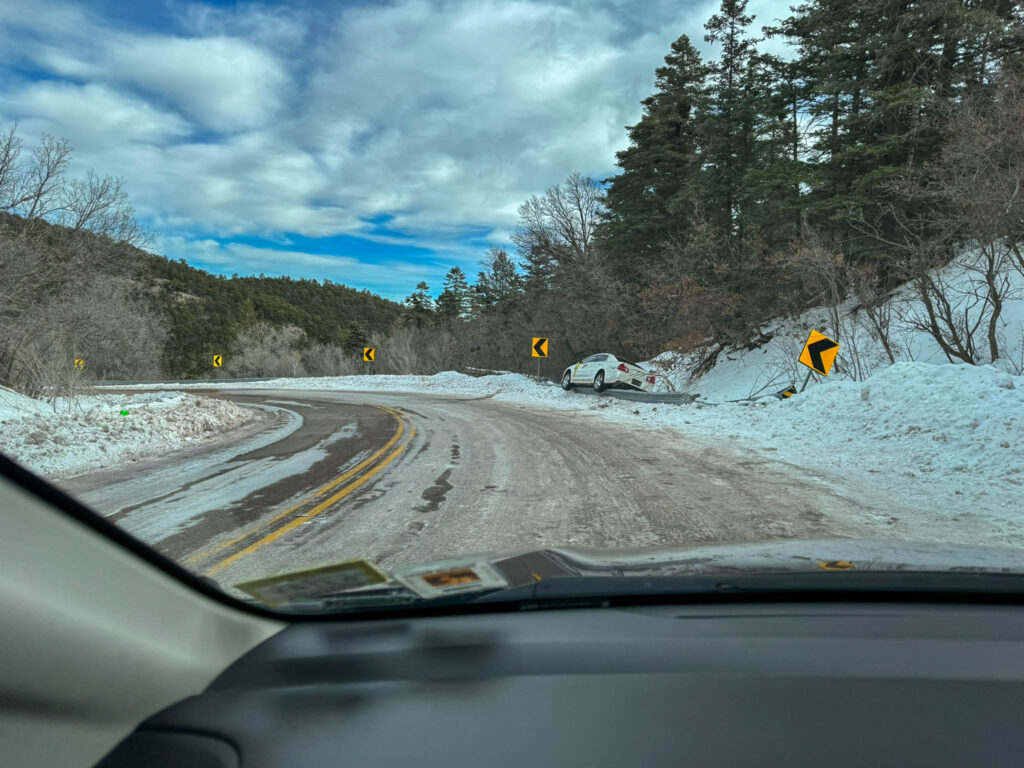
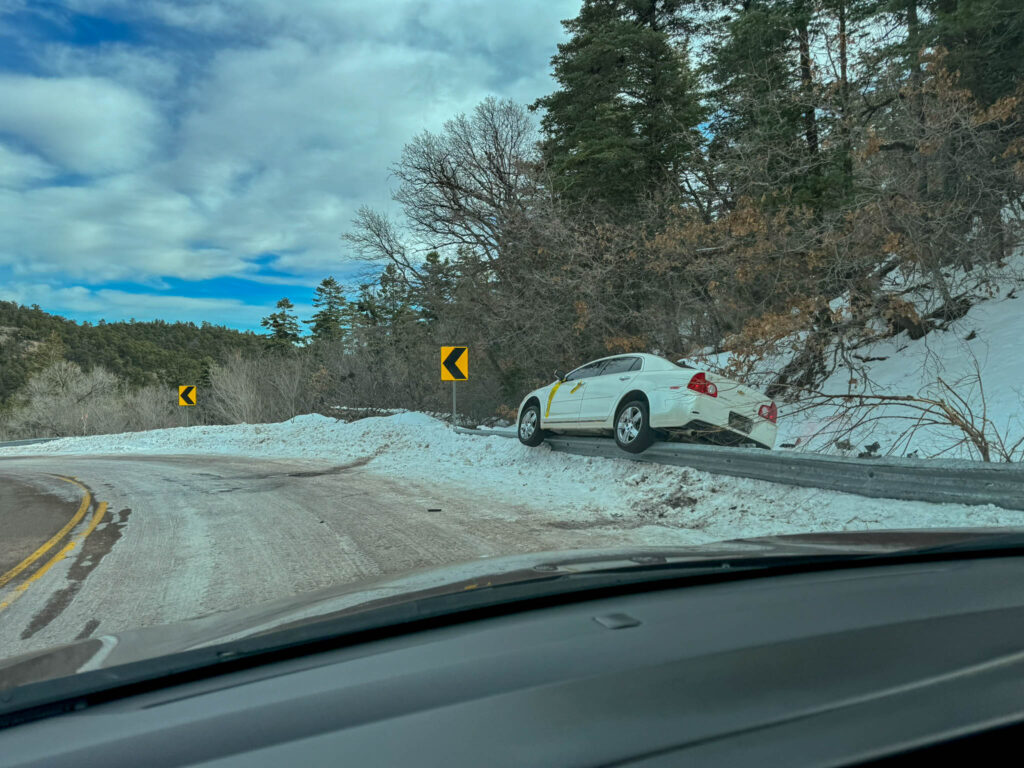
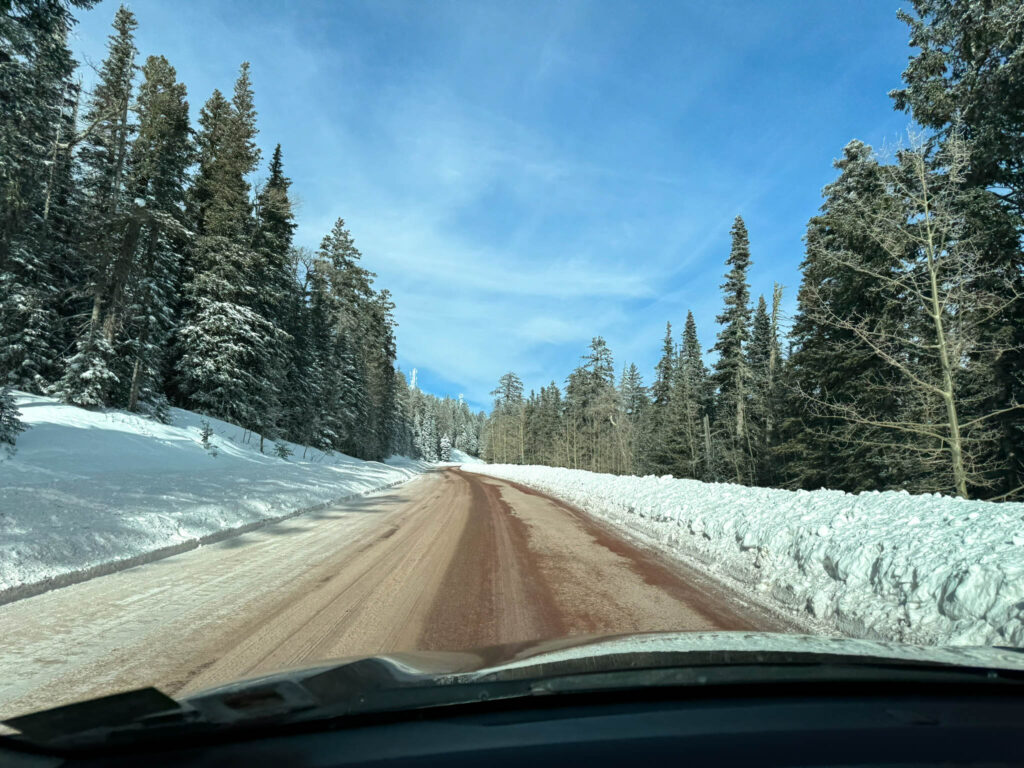
Parking at the summit
Whew, you made it! Once you get to the top, you’ll have the option to turn left into a large parking lot, or continue higher to a small loop, where some people drop off passengers at the Crest House or scenic overlook. Unfortunately, the Crest House is no longer open, and I haven’t heard of any plans for them to re-open anytime soon.
You’ll want to park towards the far end of the large parking lot (close to the distant, white car in the photo below), which looks like this:
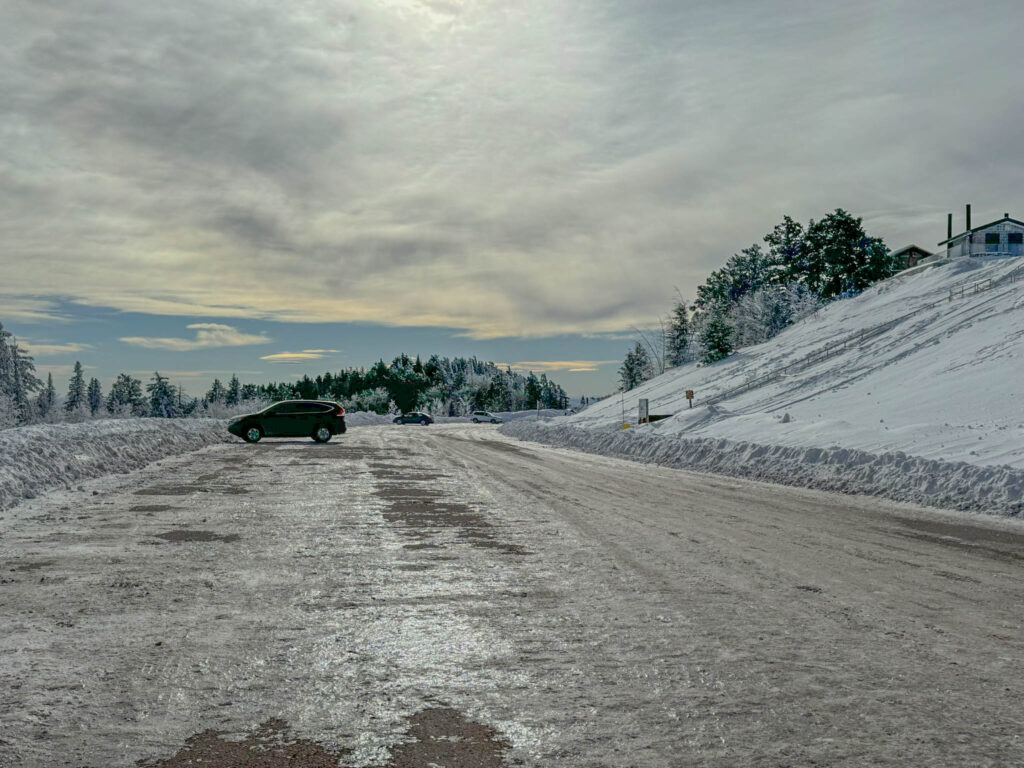

As you drive towards the end of the parking lot, you may notice a few cars parked facing uphill. Those are likely birders who are viewing the bird feeder from the comfort of their car.
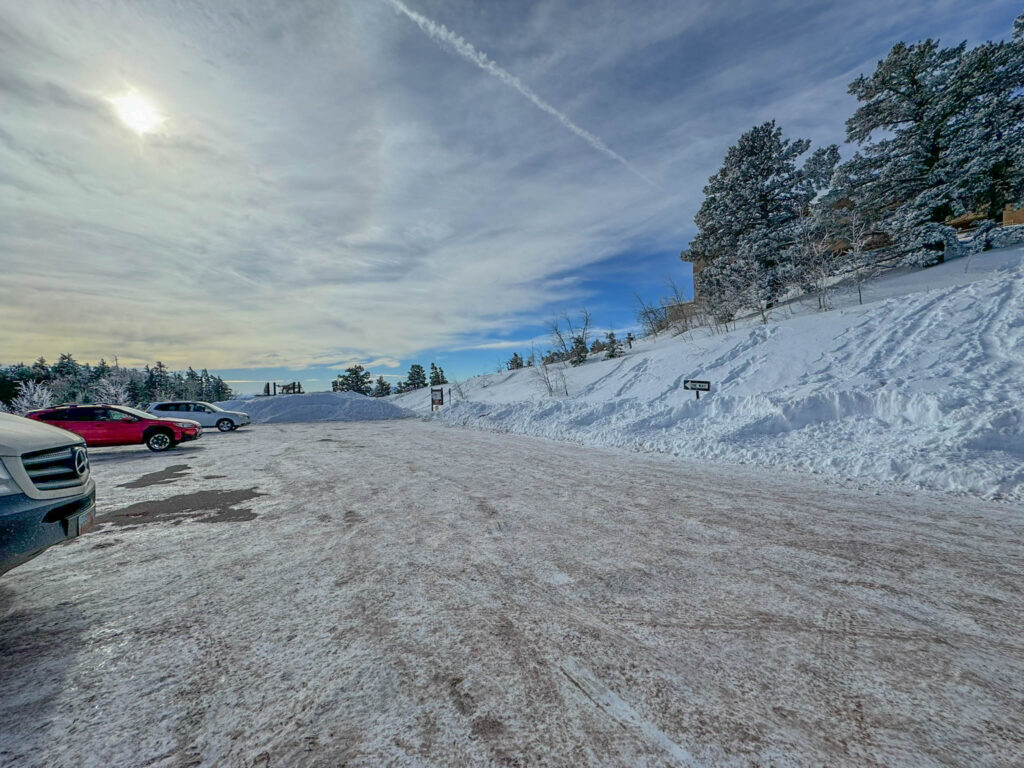
There are several pay stations available for parking ($3 per vehicle for a day pass, or $10 for high occupancy vehicle with 15+ passengers), unless you have a New Mexico Enchantment Pass or other approved pass. These aren’t fancy electronic pay stations that issue change. This is the old school method where you grab one of the provided envelopes, write down the required information, put money in the envelope, seal it, and drop it in the slot. There are no staff members around to issue change, but there are people who make the rounds periodically to issue tickets for those who haven’t paid.
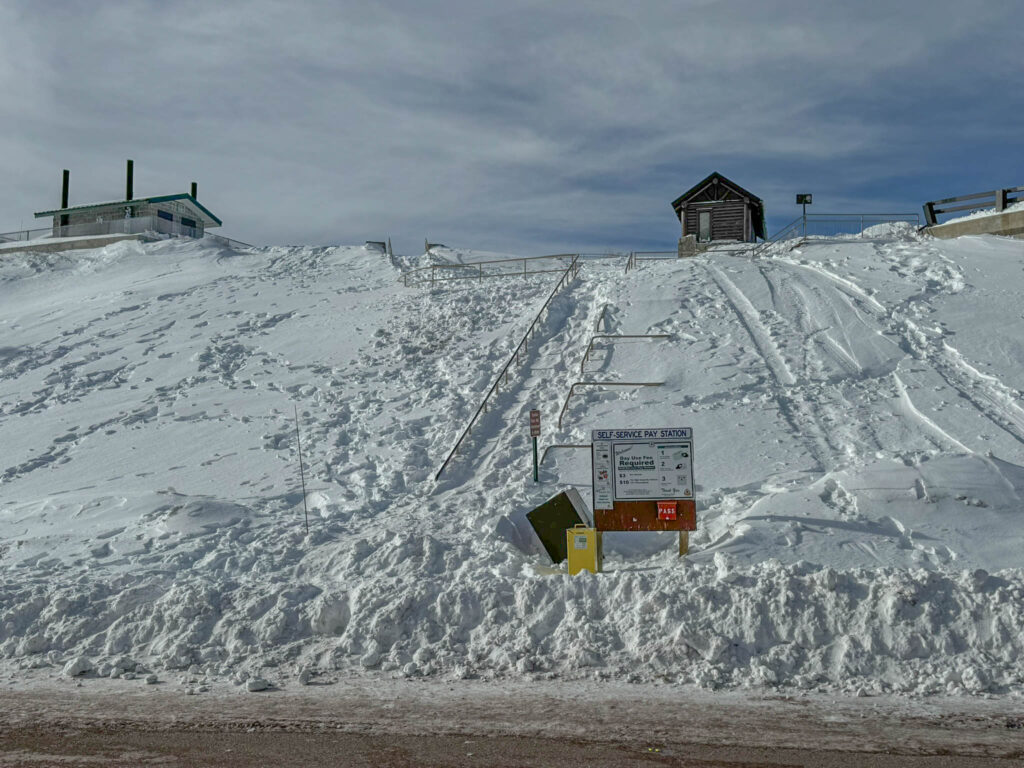
Birding Sandia Crest
“The bird feeder”
Birders looking for rosy finches will be seeking “the feeder” that is stocked by Audubon Society volunteers. There used to be additional bird feeders on the other side of the Crest House when that business was open. Since the Sandia Crest House is now closed, there’s just the one feeder near the parking lot.
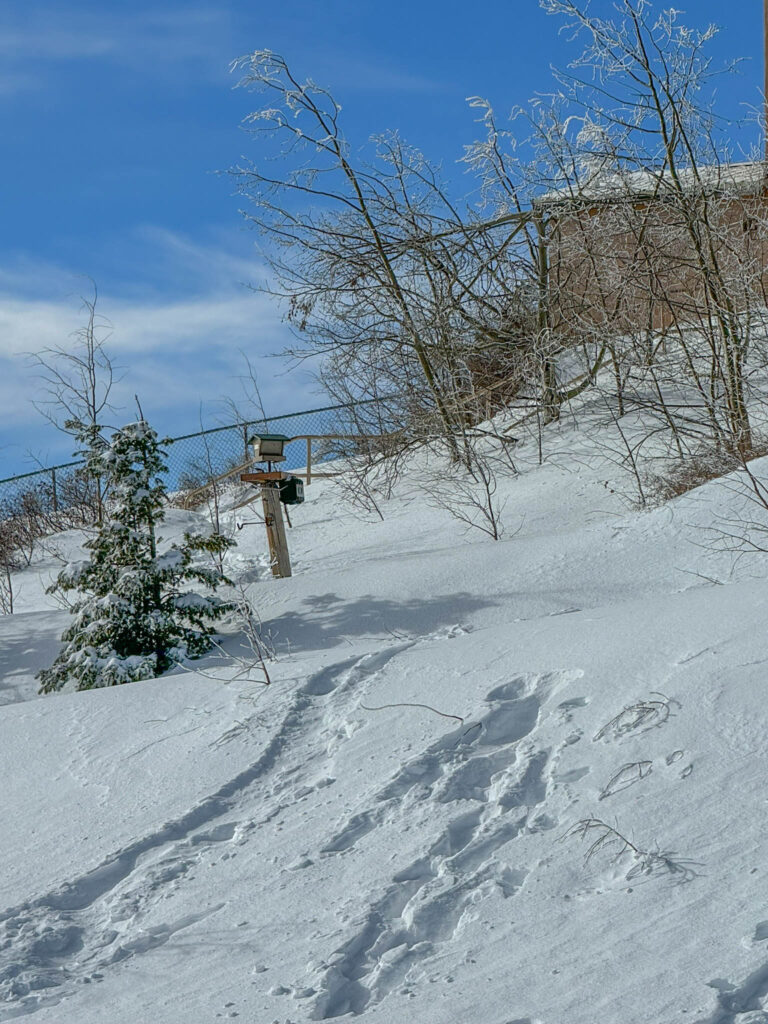
The first species I saw on the feeder during my visit was …. drum roll please …
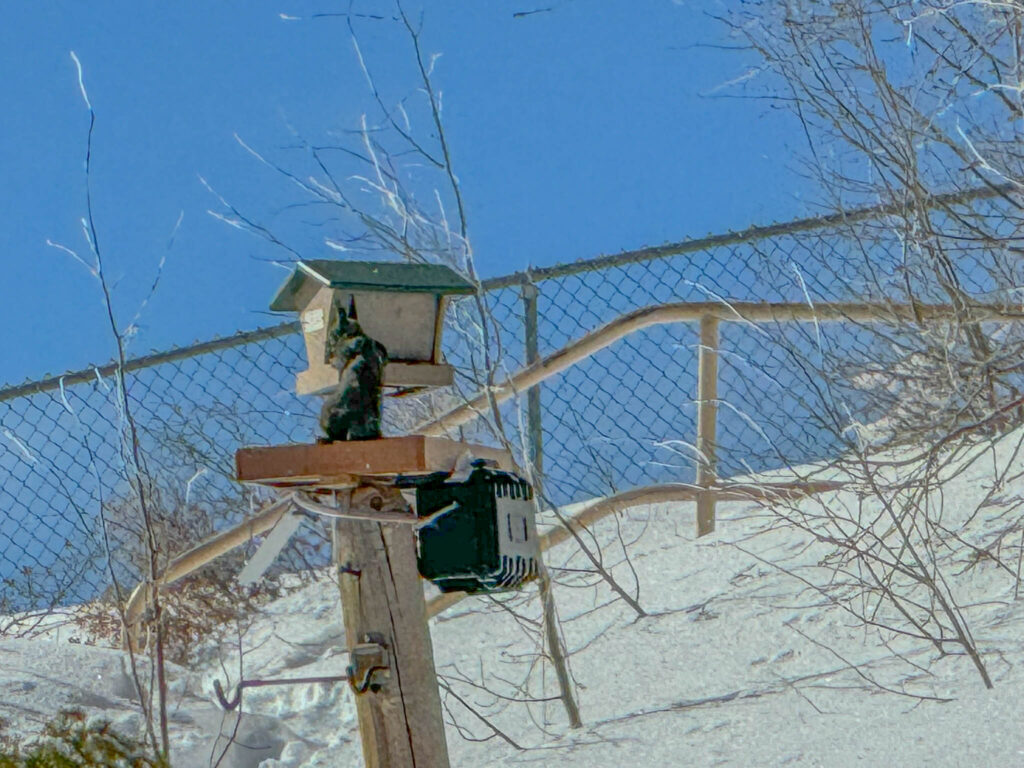
Before I go any further, it’s time for a quick primer on rosy finches.
“What’s a Rosy Finch”?
Well, for starters, there are three types of rosy-finches: black rosy-finch, brown-capped rosy-finch, and a gray-crowned rosy-finch. The hard part about seeing rosy-finches is their preference for hanging out in alpine environments near snowline. In addition, if you look at their range maps, you can see the three species overlap in just a few places in the United States, and Sandia Crest is one of them. In fact, Sandia Crest happens to be one of the best, and easiest, spots in the country to find all three species mingling together in mixed flocks.
According to the New Mexico Bird Finding Guide by William Howe (an awesome book that I highly recommend if you plan to do any birding in New Mexico), the size of the flock varies from year to year, but generally ranges between 20 – 300 birds. Black and brown-capped rosy-finches are typically more common, and gray-crowned rosy-finches are less common.
An organization called Rio Grande Bird Research Inc. has been studying and banding rosy-finches on Sandia Crest for over twenty years. Rio Grande Bird Research is a group of volunteers who conduct bird research in the Middle Rio Grande and, weather permitting, they do weekly bird banding each Sunday at Sandia Crest, which the public is welcome to observe. In the 20 years that Rio Grande Bird Research has been continuously bird banding at Sandia Crest, they’ve banded over 3,000 rosy-finches.
Based on Rio Grande Bird Research’s Facebook page, we have about 50 birds regularly visiting the feeder so far this winter, and that number is expected to increase in the coming weeks. According to Rio Grande Bird Research’s post on 1/5/24, “This year appears to be a relatively typical year with the dominant species being the Black, followed by the Brown-capped, and then the Gray-Crowned.”
If you’d like to support Rio Grande Bird Research’s important work with Rosy Finches and the other bird species of the Middle Rio Grande Valley, they accept checks made out to “Rio Grande Bird Research Inc.” and sent to P.O. Box 6557, Albuquerque NM 87197. They also accept donations (cash or check) in person while bird banding on Sundays (weather permitting) at the Sandia Crest House.
One important thing to keep in mind about rosy-finches on Sandia Crest is that they’re only here for the winter. According to William Howe’s New Mexico Bird Finding Guide, rosy-finches start to arrive in the first half of November and some of the birds stick around well into March. If you’re visiting between April – October, you’re probably out of luck, although there are plenty of other interesting bird species to keep you occupied any time of year. But if you’re specifically hoping to see rosy-fiches, then plan on visiting between December through February.
Ryan Beaulieu, Raymond VanBuskirk and the Rosy-Finch Project
The origin of the Rosy-Finch Project at Sandia Crest has an interesting and tragic backstory. In 2003, two teen birders, Raymond VanBuskirk and Ryan Beaulieu became enchanted with the rosy finches at the Sandia Crest feeders and decided to team up with Rio Grande Bird Research to do an ecology study of the birds. Two years later (in 2005), Raymond and Ryan were birding in Eastern New Mexico when they had a car accident. Sadly, Ryan was killed in the accident.
In memory of Ryan’s passion for rosy-finches, the Rosy-Finch Project continued and there’s a plaque that hangs over the rosy-finch feeders at the Sandia Crest house in honor of Ryan. It’s a tradition to touch the plaque each time a rosy-finch is caught. And to continue another tradition that Ryan started when the project began, each bird receives a little kiss before they’re released. You can find the memorial page for Ryan Beaulieu by clicking on this link.
About a decade after Ryan’s death, I was fortunate to go on a birding trip to Sandia Crest with Raymond VanBuskirk and Kenn Kaufman, which included a tribute from Raymond to Ryan Beaulieu. Today, Raymond is a sought-after birding guide, who leads tours and workshops in North and Central America.
Kenn Kaufman is a well known author and artist who also has an interesting backstory. Kenn started birding when he was six years old, and he quickly became obsessed. When he was sixteen years old, he dropped out of high school to hitchhike across North America to look for birds. A few years later (in 1973), Kenn won the annual birding competition known as the “Big Year”, where participants try to find as many bird species as possible from midnight on January 1st to 11:59pm on December 31st. He covered about 80,000 miles in his quest to win the competition that year, clocking in with 671 species that year. Kenn documented his adventures in a book called Kingbird Highway: The Biggest Year in the Life of an Extreme Birder.
Kenn went on to publish a series of field guides such as the Kaufman Field Guide to Birds of North America, Kaufman Field Guide To Advanced Birding, Kaufman Field Guide to Insects of North America, Kaufman Field Guide To Butterflies Of North America, Kaufman Field Guide to Mammals of North America, and A Season on the Wind: Inside the World of Spring Migration. Kenn also has a new book (available for pre-order) coming out in May 2024 called The Birds That Audubon Missed: Discovery and Desire in the American Wilderness.
What’s it like to bird at “the feeder” on Sandia Crest?
Well, for starters, it can be cold and windy, which is basically what I experienced when I went there on 12/26/23. There were three other cars at the Crest that day. I met one guy who was walking around, and we said hello. Not surprisingly, he turned out to be a birder. We had a fun conversation as we tromped through the snow to find the bird feeder. He’d just been down at Elephant Butte to see a rufous-backed robin and Nutting’s flycatcher (both are very unusual to see) and now he was hoping to see the three species of rosy finches.
Unfortunately, we didn’t have much luck. It was a very windy day, and the rosy finches weren’t making an appearance yet. Having said that, I’ve been told it can take several hours before the rosy-finches make their rounds. On other days, they may return every 15 minutes or so. After about 30 minutes, the only birds I saw at the feeder were 6 dark-eyed juncos, 1 mountain chickadee, and 1 red-breasted nuthatch. Since I happen to live in Sandia Park, I decided to call it quits and try again on a nicer day.
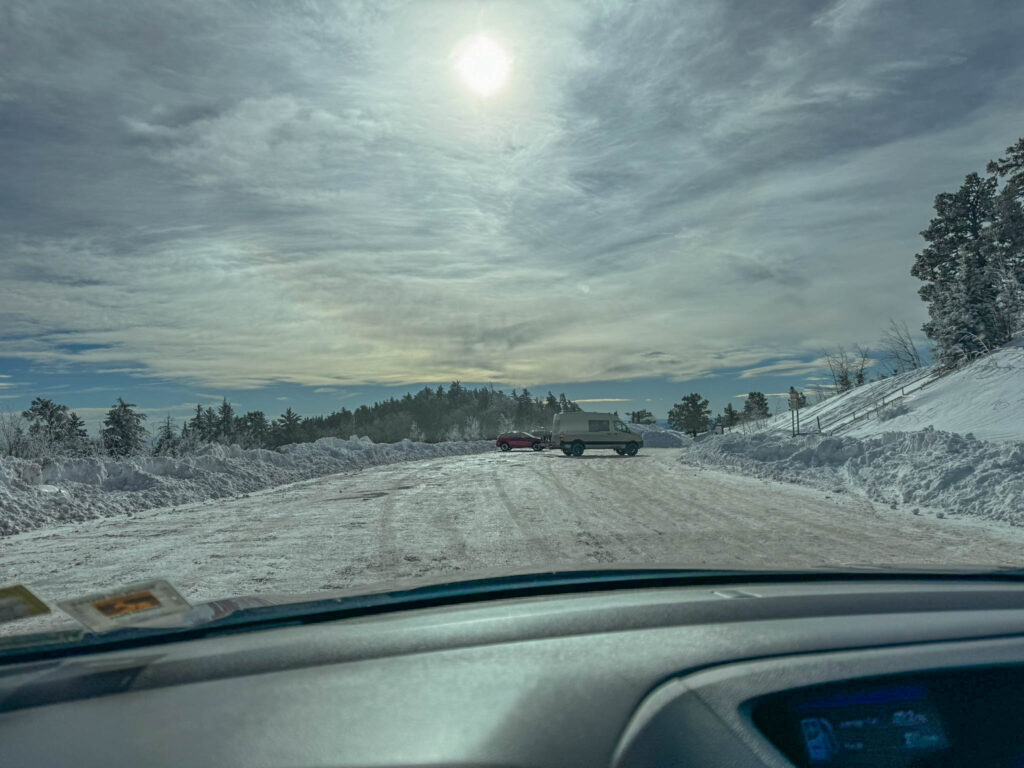
A few days later, I looked up some checklists on eBird to see if anyone was having luck with the rosy-finches. It turned out that the person I’d met recorded that he’d seen 3 rosy finches: 1 black, 1 brown-capped, and 1 gray-crowned. Given that rosy finches are typically in a flock in winter, it seemed pretty amazing that he saw just three rosy finches, with one representative from each of the three species. The odds of that happening, combined with the fact that many birders get a wee bit competitive on checklists … well, in the words of Led Zeppelin, “it makes me wonder”. But hey, stranger things have happened, which is part of the fun of birding. Plus, I enjoyed meeting that fellow birder on a cold, windy day, and I’ll give him the benefit of the doubt.
On January 1st, I returned to give it another shot. It was a cold, but beautiful, sunny day, with very little wind. When I arrived, there were two women sitting on the snow, ready to take photos of the feeder with a nice camera. We exchanged hellos and the first thing they said was, “You just missed them!”. Darn.
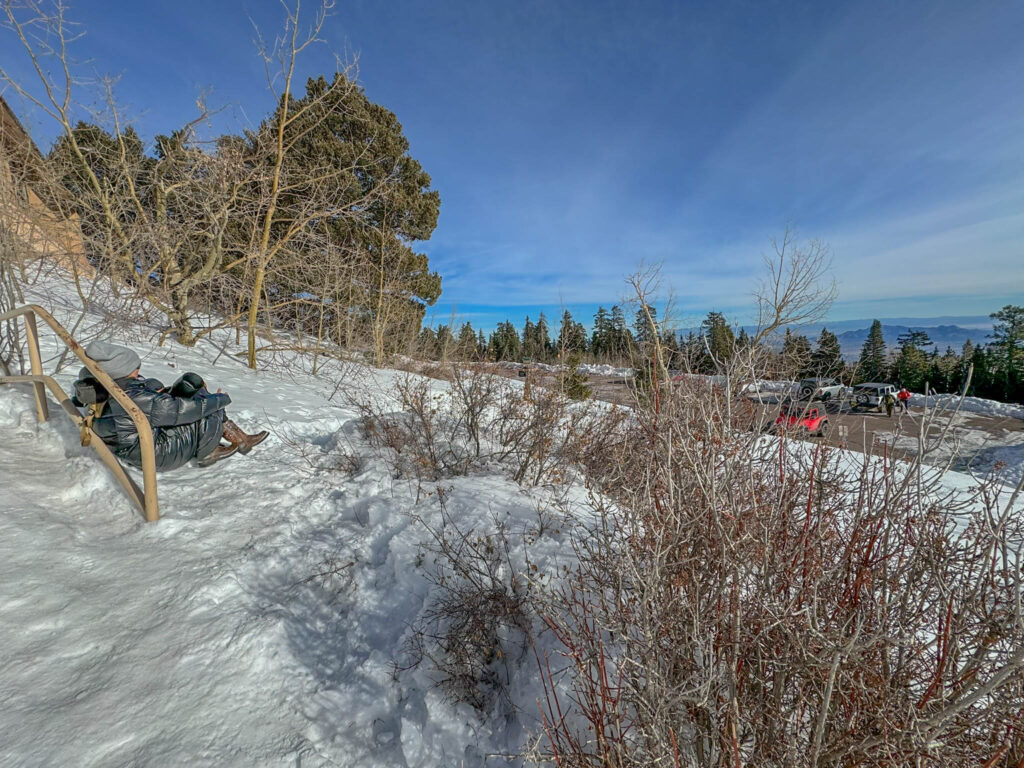
About fifteen minutes later, we heard the rosy finch flock flying behind the Sandia Crest House but couldn’t see them. But things were looking promising. Sure enough, a few of them started to land at the top of a nearby tree.
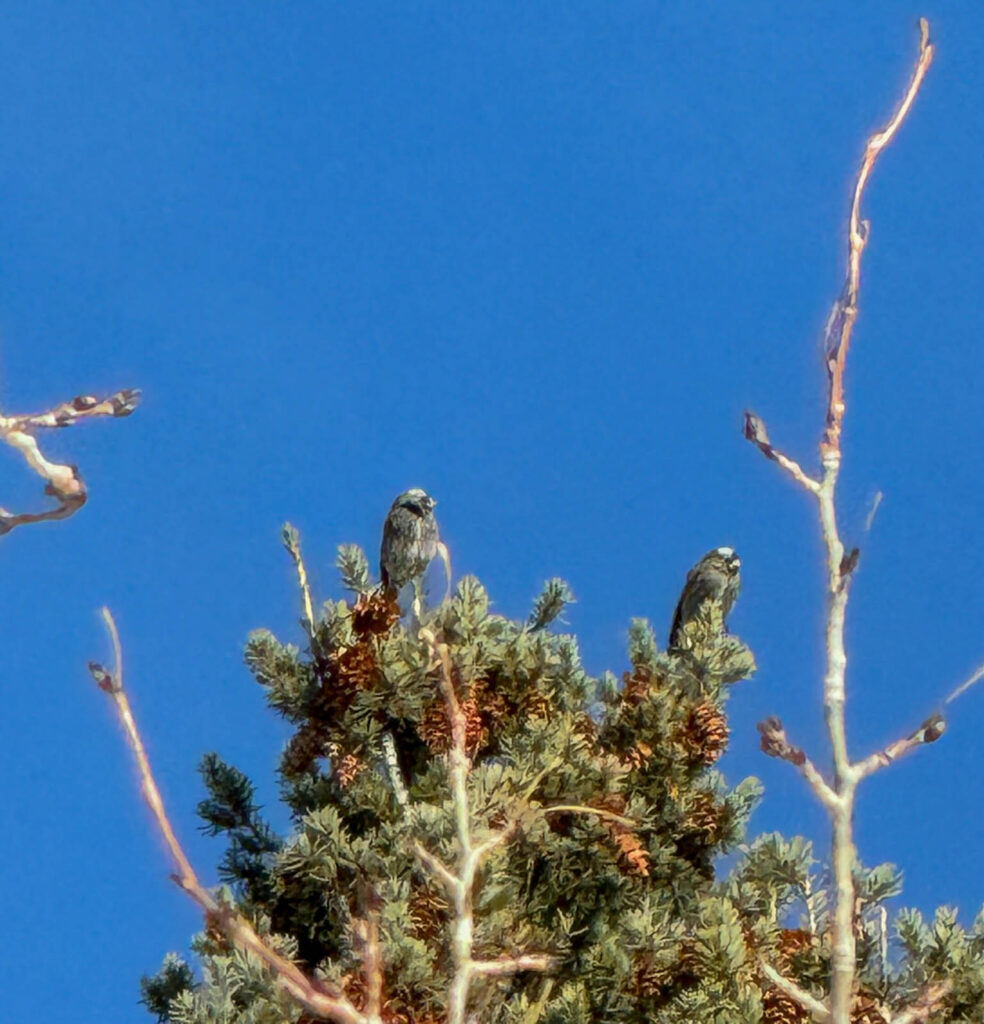
And, as advertised, a small flock decided to land on the feeder and start to feed.
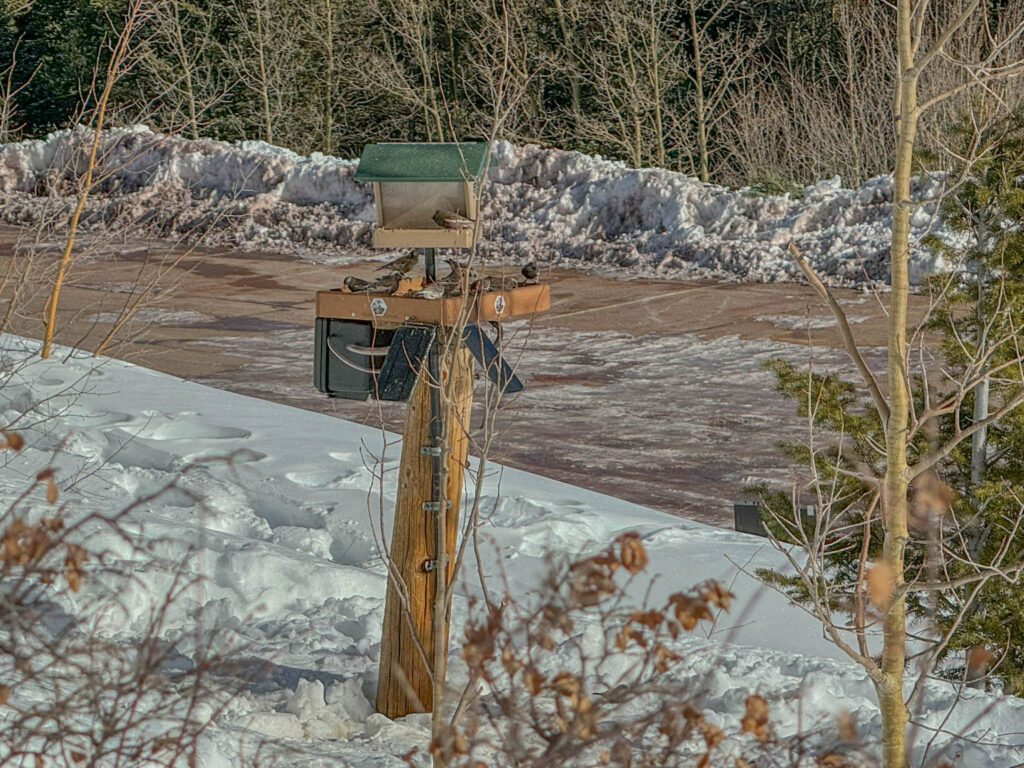
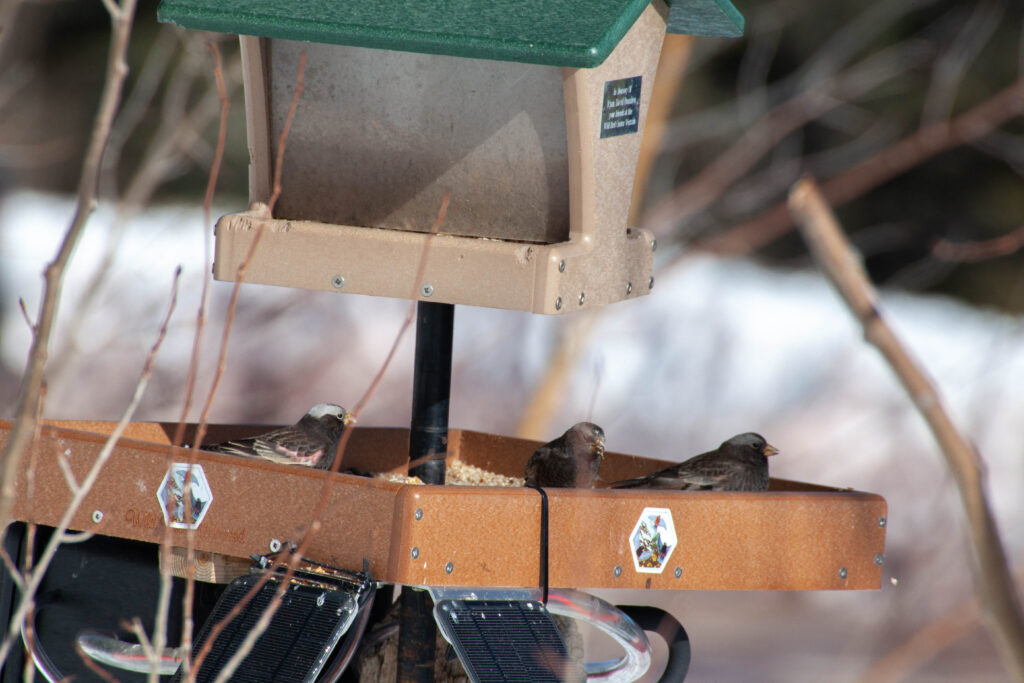
The rosy-finches soon disappeared. Then, about 20 minutes later, another batch appeared. I don’t know if it included the same birds or not. After that, I decided to walk along the nature trail to see what other birds I could find. When I returned about 45 minutes later, another small group of rosy-finches was on the feeder. As a result, it’s hard to provide an accurate estimate, but my best guess is that I saw a total of 7 black rosy-finches, 4 gray-crowned rosy-finches, and 1 brown-capped rosy finch at the feeder, in addition to 8 dark-eyed juncos and 2 red-breasted nuthatches.
Birding the hiking trails of Sandia Crest
Heading south from the feeder, I started walking along the hard-packed snow of the nature trails on the Crest. People like to go snowshoeing at the Crest, as well as other parts of Sandia Mountain, and I found that the previous efforts of snowshoers made it easy for me to hike the trails in my hiking boots without any snowshoes.
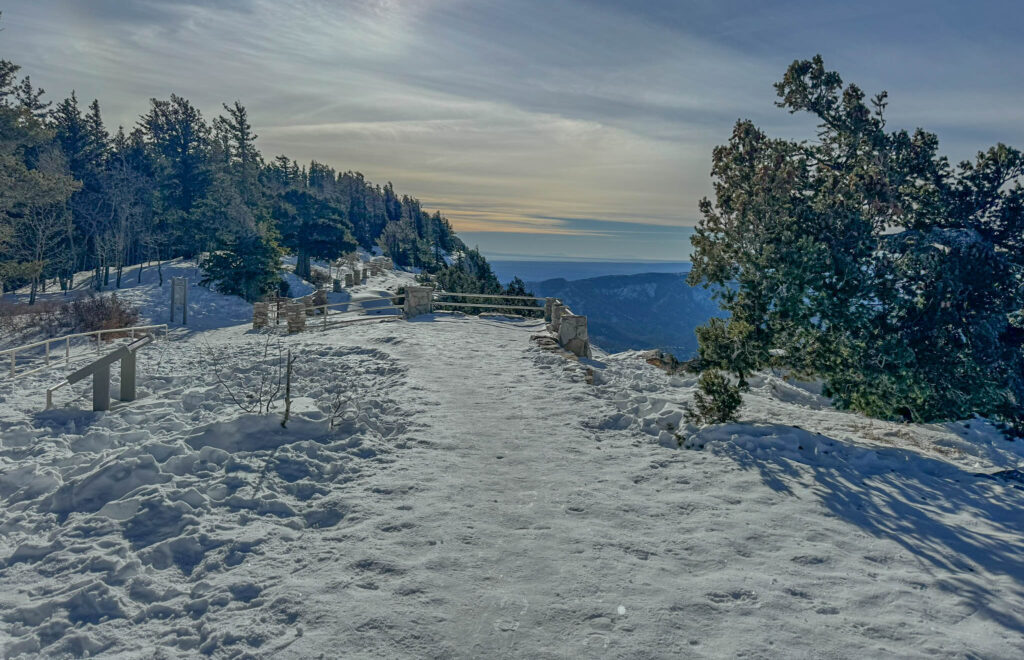
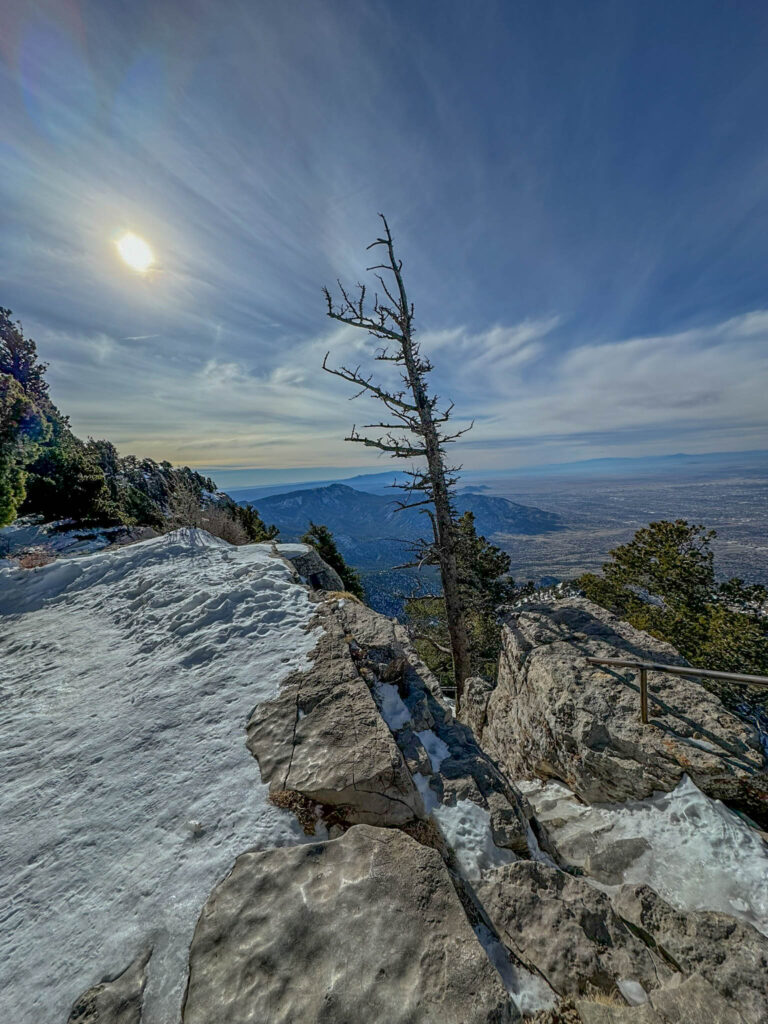
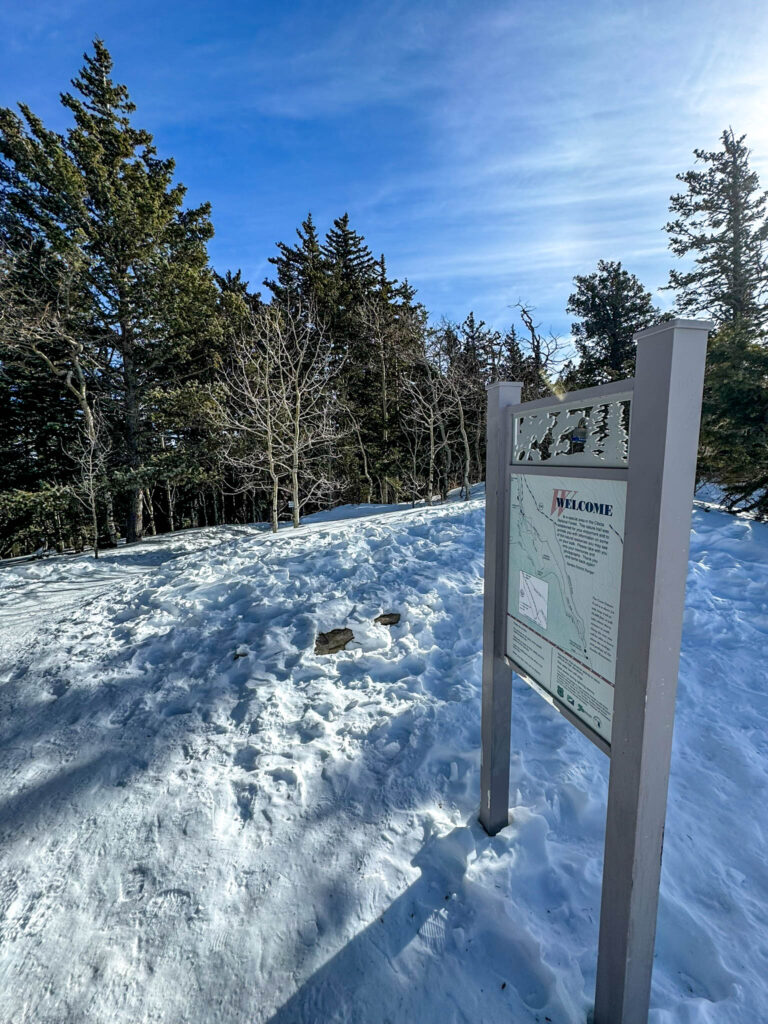
I was really hoping to run into a Three-toed woodpecker, but I wasn’t holding my breath on that one. They aren’t very easy to find. In the end, I never did see the woodpecker, but I did enjoy a nice hike through the trees and I came across 3 mountain chickadees, 2 golden-crowned kinglets, and a brown creeper.
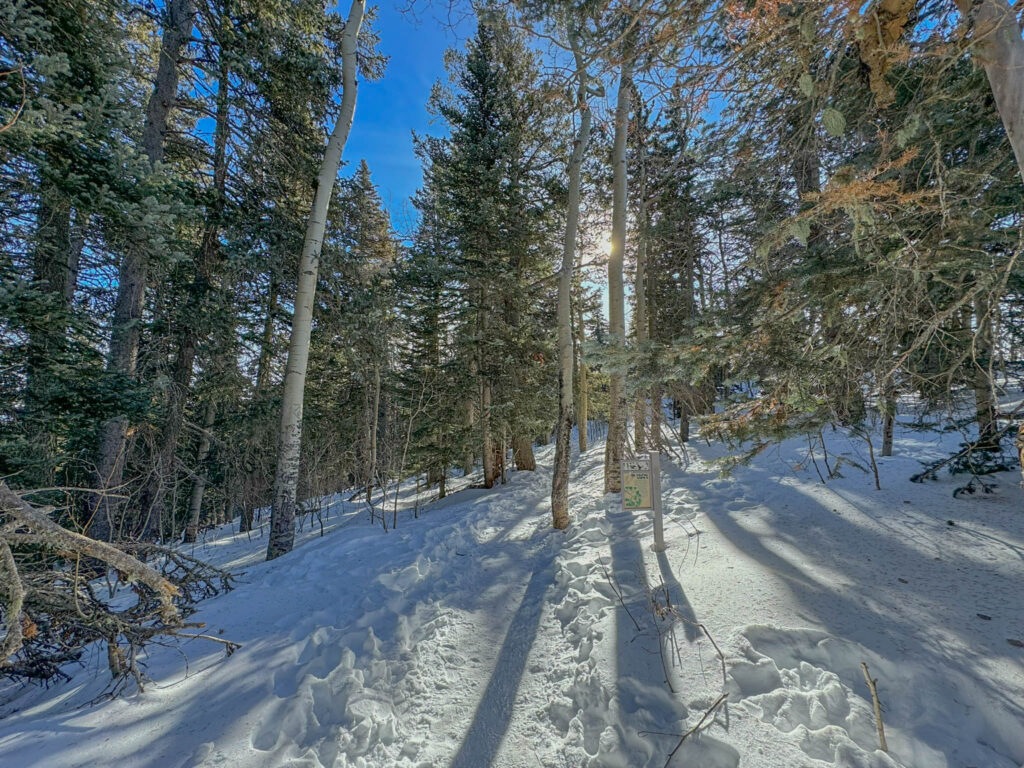
Other birding hotspots along the Sandia Crest Highway
Birding Hotspots of the Sandia Mountains
There are a number of good birding spots in the Sandia Mountains, but some favorites include the following:
- Balsam Glade
- Cienega Canyon
- Sulphur Canyon Picnic Area
- Doc Long Picnic Area
- Tree Spring Trail
You can read more about these places in William Howe’s New Mexico Bird Finding Guide.
Balsam Glade
On my way down the mountain, I decided to stop off at a birding hotspot on Sandia Mountain called Balsam Glade. I’d learned about this place from Raymond VanBuskirk and Kenn Kaufmann on the tour that I took with them many years ago. It involves a very short hike through the trees, which eventually leads to an overlook that is great for viewing raptors at the right time of year.
During my walk through the trees, I came across 6 red crossbills (males are red, females are yellow), and had the best look at both males and females that I’ve ever had through binoculars, as they picked away on conifer seeds towards the top of the trees. I also came across more dark-eyed juncos, red-breasted nuthatches, a white-breasted nuthatch, mountain chickadees and a hairy woodpecker.
As I approached the overlook, I noticed one raptor flying in the distance. It turned out to be a red-tailed hawk.
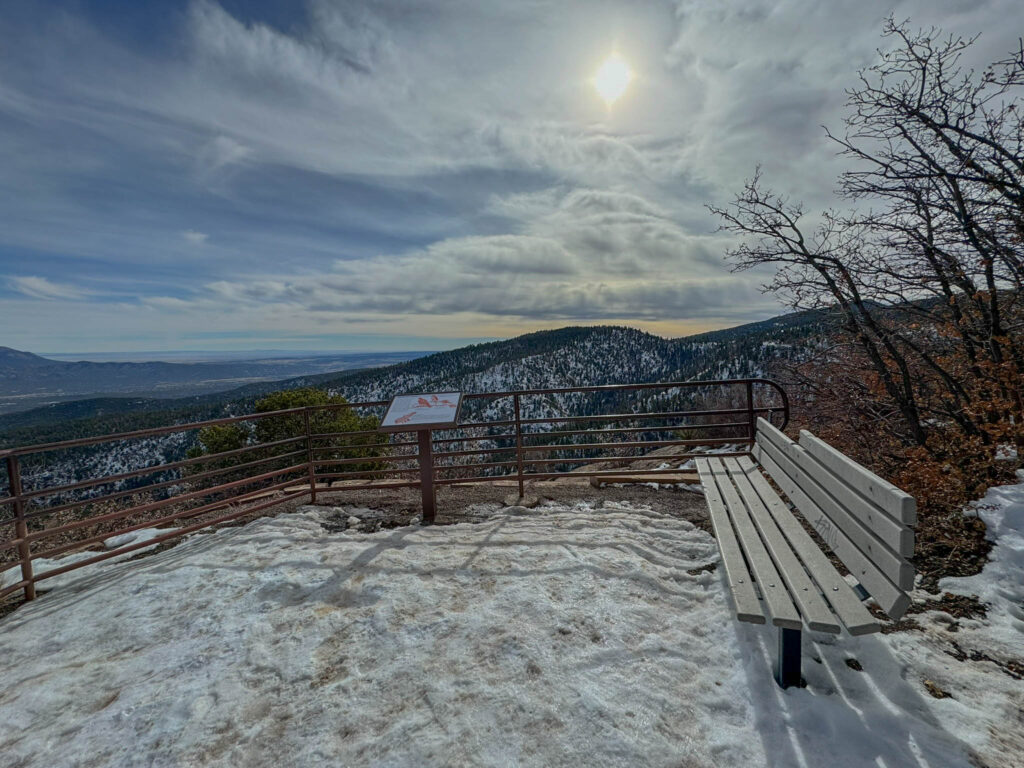
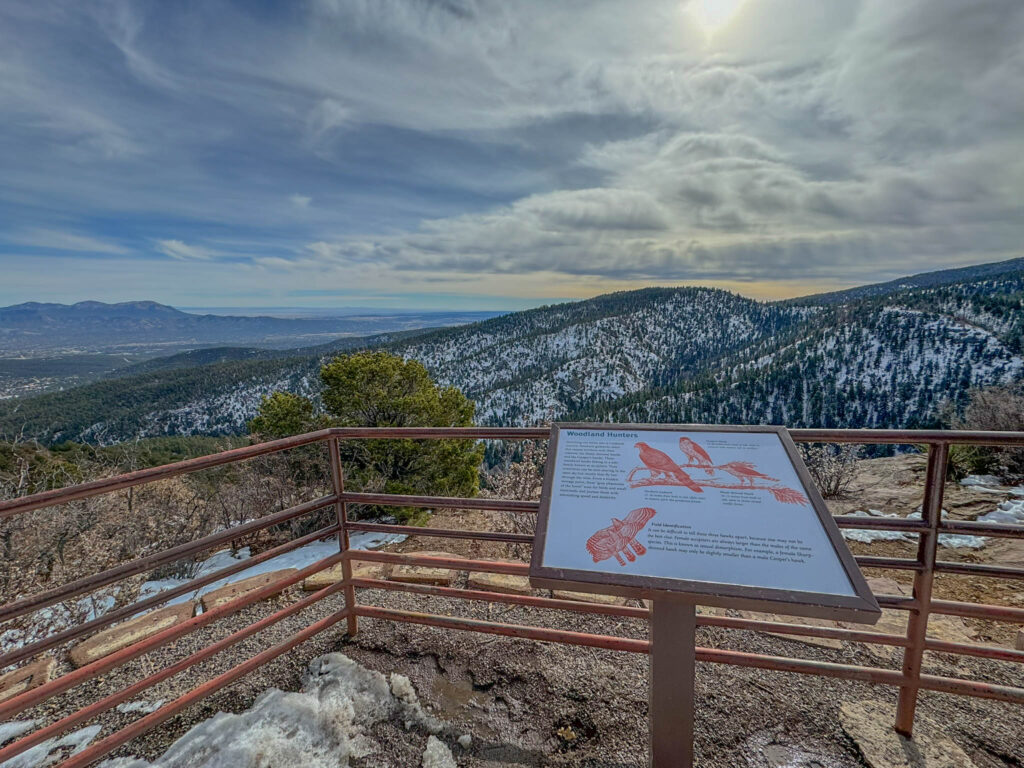
As I stood quietly at the overlook, I heard a distinct sound from below. Being a nerd, I opened up my Sibley’s Guide to Birds phone app and played the sound of a Clark’s Nutcracker. Sure enough, it was a match. I didn’t get to see it, but I definitely heard it. The Clark’s Nutcracker has a distinct sound that is described as a “grating, metallic kraak”.
A few minutes later, I heard another sound behind me that I wasn’t sure about. I went off the trail and hiked downhill a bit to see if I could locate the source. Five minutes later, I found it. Another drum roll please …
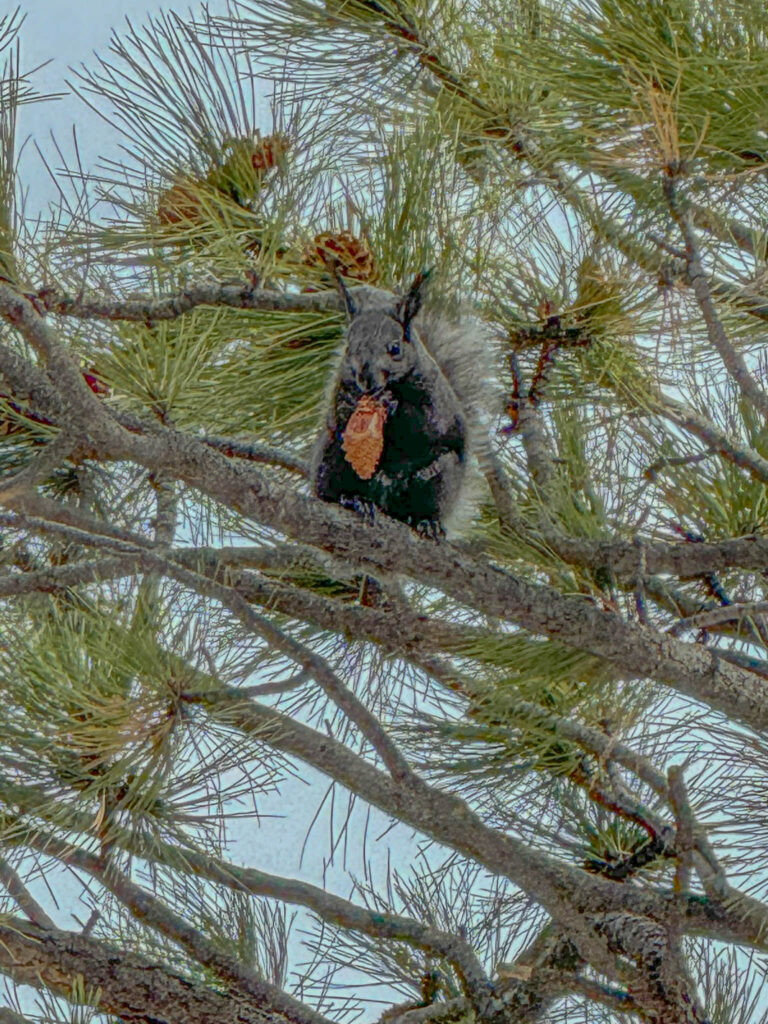
Yes, another Abert’s squirrel, apparently taunting me. But it made me smile, so it was worth it.
Thought for the Week
In memory of teenage birder Ryan Beaulieu, here’s a quote from one of his journal entries from 11/27/2004.
“I realized that I am at peace with everything when I can feel, hear, smell and see the amazing wonders that nature can provide.”
— Ryan Beaulieu
Thanks for reading and happy travels!
Mark (The New Mexico Travel Guy)

Mark Aspelin, The New Mexico Travel Guy (www.newmexicotravelguy.com), is a travel writer and author of two books who has enjoyed a wide variety of adventures in his travels to over 100 countries and all 50 U.S. States. His current project involves visiting EVERY town in his home state of New Mexico (there’s over 500 towns) and writing a story about each one. He’s on track to finish the project by his early-mid 100s. When not traveling, Mark lives as a recluse in the mountains outside of Albuquerque, New Mexico.
